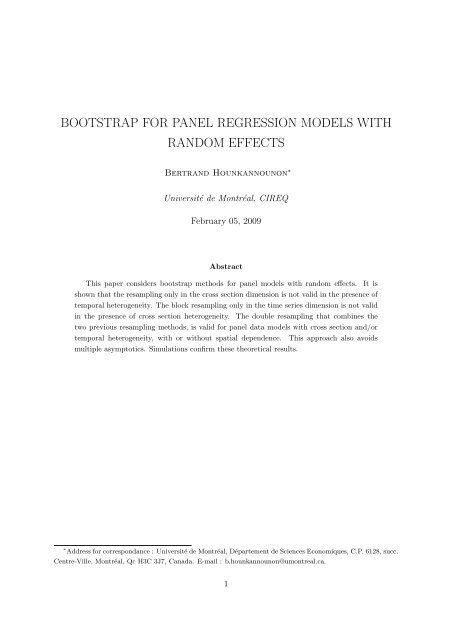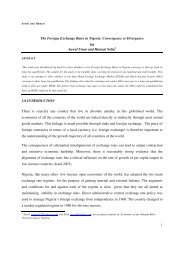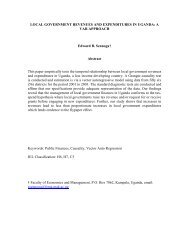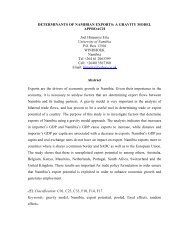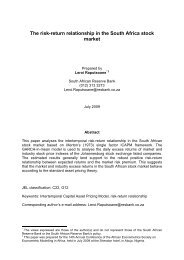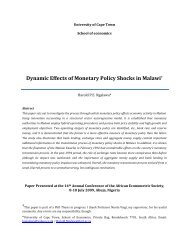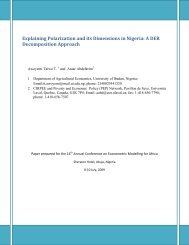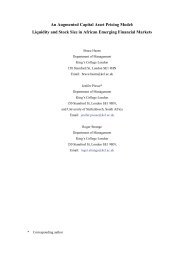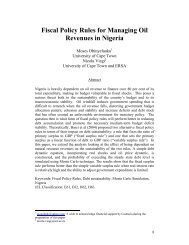bootstrap for panel regression models with random effects - African ...
bootstrap for panel regression models with random effects - African ...
bootstrap for panel regression models with random effects - African ...
You also want an ePaper? Increase the reach of your titles
YUMPU automatically turns print PDFs into web optimized ePapers that Google loves.
BOOTSTRAP FOR PANEL REGRESSION MODELS WITH<br />
RANDOM EFFECTS<br />
Bertrand Hounkannounon ∗<br />
Université de Montréal, CIREQ<br />
February 05, 2009<br />
Abstract<br />
This paper considers <strong>bootstrap</strong> methods <strong>for</strong> <strong>panel</strong> <strong>models</strong> <strong>with</strong> <strong>random</strong> <strong>effects</strong>. It is<br />
shown that the resampling only in the cross section dimension is not valid in the presence of<br />
temporal heterogeneity. The block resampling only in the time series dimension is not valid<br />
in the presence of cross section heterogeneity. The double resampling that combines the<br />
two previous resampling methods, is valid <strong>for</strong> <strong>panel</strong> data <strong>models</strong> <strong>with</strong> cross section and/or<br />
temporal heterogeneity, <strong>with</strong> or <strong>with</strong>out spatial dependence. This approach also avoids<br />
multiple asymptotics. Simulations confirm these theoretical results.<br />
∗ Address <strong>for</strong> correspondance : Université de Montréal, Département de Sciences Economiques, C.P. 6128, succ.<br />
Centre-Ville, Montréal, Qc H3C 3J7, Canada. E-mail : b.hounkannounon@umontreal.ca.<br />
1
1 Introduction<br />
The true probability distribution of a test statistic is rarely known. Generally, its asymptotic<br />
law is used as approximation of the true law. If the sample size is not large enough, the<br />
asymptotic behavior of that statistic could lead to a poor approximation of the true one. Using<br />
<strong>bootstrap</strong> methods, under some regularity conditions, it is possible to obtain a more accurate<br />
approximation of the distribution of the test statistic. The original <strong>bootstrap</strong> procedure has<br />
been proposed by Efron (1979) <strong>for</strong> statistical analysis of independent and identically distributed<br />
(i.i.d.) observations. It is a powerful tool <strong>for</strong> approximating the distribution of complicated<br />
statistics based on i.i.d. data. Since Efron (1979) there has been an extensive research to<br />
extend the <strong>bootstrap</strong> to statistical analysis of non i.i.d. data. Several <strong>bootstrap</strong> procedures<br />
have been proposed <strong>for</strong> time series. The two most popular approaches are the sieve <strong>bootstrap</strong><br />
and the block <strong>bootstrap</strong>. For an overview of <strong>bootstrap</strong> methods <strong>for</strong> dependent data, see Lahiri<br />
(2003). Application of <strong>bootstrap</strong> methods to multiple indices data is an embryonic research<br />
field. Multiple indices data include clustered data, multilevel data, and <strong>panel</strong> data.<br />
The term ”<strong>panel</strong> data” refers to the pooling of observations on a cross-section of statistical units<br />
over several periods. Because of their two dimensions, cross section and time series, <strong>panel</strong> data<br />
have the important advantage to allowing the researcher to control <strong>for</strong> unobservable heterogeneity,<br />
that is systematic difference across cross-sectional units or periods. For an overview of <strong>panel</strong><br />
data <strong>models</strong>, see <strong>for</strong> example Baltagi (1995) or Hsiao (2003). There is an abounding literature<br />
on asymptotic theory <strong>for</strong> <strong>panel</strong> data <strong>models</strong>. Some recent developments treat large <strong>panel</strong>s,<br />
when temporal and cross section dimensions are both important. However, the theoretical literature<br />
about <strong>bootstrap</strong> methods <strong>for</strong> <strong>panel</strong> data is rather recent. Kapetanios (2008) presents<br />
theoretical results when the cross-sectional dimension goes to infinity, under the assumption<br />
that cross-sectional vectors of regressors and errors terms are i.i.d.. Gonçalves (2008) shows the<br />
first order asymptotic validity of the moving blocks <strong>bootstrap</strong> <strong>for</strong> fixed <strong>effects</strong> OLS estimators<br />
of <strong>panel</strong> linear <strong>regression</strong> <strong>models</strong> <strong>with</strong> individual fixed <strong>effects</strong>. Analyzing the sample mean,<br />
Hounkannounon (2008) explores the validity of several the <strong>bootstrap</strong> resamplings methods <strong>for</strong><br />
<strong>panel</strong> data. The main result of this paper is to provide the double resampling <strong>bootstrap</strong> that<br />
combines resampling in cross-sectional dimension and block resampling in temporal dimension.<br />
This special method is valid in the presence of cross-sectional and temporal heterogeneity, and<br />
also in the presence of spatial dependence. This paper aims to extend these results to linear<br />
<strong>regression</strong> model. The paper is organized as follows. In the second section, different <strong>panel</strong> data<br />
<strong>models</strong> are presented. Section 3 presents three <strong>bootstrap</strong> resampling methods <strong>for</strong> <strong>panel</strong> data.<br />
The fourth section presents theoretical results, analyzing validity of each resampling method.<br />
In section 5, simulation results are presented to confirm theoretical results. The sixth section<br />
concludes. Proofs of propositions are given in the appendix.<br />
2
2 Panel Data Models<br />
It is practical to represent <strong>panel</strong> data as a matrix. By convention, in this document, rows<br />
correspond to the cross-sectional units and columns represent time periods. A <strong>panel</strong> dataset<br />
<strong>with</strong> N cross-sectional units and T time periods is represented by a matrix Y of N rows and T<br />
columns. Thus Y contains NT elements. y it is the cross-sectional i ′ s observation at period t.<br />
⎛<br />
Y = (N,T ) ⎜<br />
⎝<br />
⎞<br />
y 11 y 12 ... ... y 1T<br />
y 21 y 22 ... ... y 2T<br />
... ... ... ... ...<br />
⎟<br />
... ... ... .. ... ⎠<br />
y N1 y N2 .. ... y NT<br />
(2.1)<br />
Multiple Asymptotics<br />
The double indexes imply several ways to analyze asymptotic <strong>with</strong> <strong>panel</strong> . One index can be<br />
fixed and the other goes to infinity. In the second case, how N and T go to infinity, is not<br />
always <strong>with</strong>out consequence. Hsiao (2003 p. 296) distinguishes three approaches : sequential<br />
limit, diagonal path limit and joint limit. A sequential limit is obtained when an index is fixed<br />
and the other passes to infinity, to have intermediate result. The final result is obtained by<br />
passing the fixed index to infinity. In case of diagonal path limit, N and T pass to infinity along<br />
a specific path, <strong>for</strong> example T = T (N) and N → ∞. With joint limit, N and T pass to infinity<br />
simultaneously <strong>with</strong>out a specific restrictions. In some times it can be necessary to control<br />
relative expansion rate of N and T . It is obvious that joint limit implies diagonal path limit.<br />
For equivalence conditions between sequential and joint limits, see Phillips and Moon (1999).<br />
In practice, it is not always clear how to choose among these multiple asymptotic distributions<br />
which may be different.<br />
Panel Model Specifications<br />
Consider a <strong>panel</strong> linear model<br />
y it = θ + V i τ + W t γ + X it ζ + ν it = Z it β + ν it (2.2)<br />
β =<br />
(K,1)<br />
⎛<br />
⎜<br />
⎝<br />
θ<br />
τ<br />
γ<br />
ζ<br />
⎞<br />
⎟<br />
⎠<br />
(2.3)<br />
3
Three kinds of variables are considered : cross-section varying variables V i , time varying variable<br />
W t and double dimensions varying variables X it . β is an unknown vector of parameters. The<br />
allow the identification of θ, the regressors must be centered. Inference will be about these<br />
parameters and consists in building confidence intervals <strong>for</strong> each component β k of β.<br />
Assumptions about ν it define different <strong>panel</strong> data <strong>models</strong>. The general specification is (2.4)<br />
under assumptions below :<br />
Assumptions A<br />
A1 : (µ 1 , µ 2 , .., µ N ) ∼ i.i.d. ( 0, σ 2 µ)<br />
, σ<br />
2<br />
µ ∈ (0, ∞)<br />
A2 : {f t } is a stationary and strong α-mixing process :<br />
ν it = µ i + f t + λ i F t + ε it (2.4)<br />
α (j) = sup {|P (A ∩ B) − P (A) P (B)|} , j ∈ N where A ∈ σ 〈{f t : t ≤ k}〉 , B ∈ σ 〈{f t : t ≥ k + j + 1}〉 ,<br />
k ∈<br />
Z , <strong>with</strong> α (j) → 0 as j → ∞. E (f t ) = 0 and {f t } verifies Ibragimov’s conditions : ∃, δ ∈<br />
(0, ∞) , E |f t | 2+δ < ∞, ∑ ∞<br />
j=1 α (j)δ/(2+δ) < ∞,<br />
V ∞<br />
f<br />
= ∑ ∞<br />
h=−∞ Cov (f t, f t+h ) ∈ (0, ∞).<br />
A3 : {F t } is a stationary and strong α-mixing process <strong>with</strong> E (F t ) = 0 verifying Ibragimov’s<br />
conditions.<br />
A4 : (λ 1 , λ 2 , .., λ N ) ∼ i.i.d. ( 0, σ 2 λ)<br />
, σ<br />
2<br />
λ<br />
∈ (0, ∞)<br />
A5 : {ε it } i=1...N, t=1..T<br />
∼ i.i.d. ( 0, σ 2 ε)<br />
, σ<br />
2<br />
ε ∈ (0, ∞) A6 : √ Nε<br />
A7 : √ T ε<br />
P<br />
→<br />
N,T →∞ 0.<br />
P<br />
→<br />
N,T →∞ 0<br />
A8 : The time varying processes are independent of the cross-section varying process.<br />
(2.4) is a two-way error component model (ECM) <strong>with</strong> spatial dependence. The term ECM<br />
comes from the structure of error terms. µ i and f t are respectively systematic differences across<br />
units and time periods. Classical papers on error component <strong>models</strong> include Balestra and Nerlove<br />
(1966), Fuller and Battese (1974) and Mundlak (1978). It is important to emphasize that the<br />
unobservable heterogeneity here is a <strong>random</strong> variable, not a parameter to be estimated. The<br />
alternative is to use the fixed <strong>effects</strong> model in that the heterogeneities are parameters 1 . The<br />
product λ i F t allows the common factor F t to have differential <strong>effects</strong> on cross-section units.<br />
This specification is used by Bai and Ng (2004), Moon and Perron (2004) and Phillips and Sul<br />
(2003). It is a way to introduce dependence among cross-sectional units. (2.4) uses a single<br />
1 Fixed effect in one dimension has a immediate consequence : parameters associated to the regressors varying<br />
only in this dimension become unidentified<br />
4
factor. a multiple factor model is also possible : ∑ L<br />
l=1 λL i F L t <strong>with</strong> L finite or infinite. Another<br />
approach to introduce dependence a consists to use a spatial model in which the structure of<br />
the dependence can be related to geographic, economic or social distance (see Anselin (1988)).<br />
Assumption A1 is usual <strong>for</strong> cross-sectional heterogeneity : each unit has his specificity that does<br />
not depend on the others unobservable heterogeneity. A3 allows weak dependence <strong>for</strong> {f t } and<br />
{F t }. The fact to impose the loadings λ i and the factor F t to have expectations equals to zero,<br />
is not restrictive. If E (F t ) = F ≠ 0 and E (λ i ) = λ ≠ 0, it is possible to introduce centered<br />
variables F c t = F t −F, λ c i = λ i−λ and λ i F t +ε it = (λ c i + λ) (F c t + F ) = λF +λ c i F +λF c t +λ c i F c t =<br />
η + U i + Γ t + λ c i F c t + ε it : a two-way ECM <strong>with</strong> spatial dependence. In order to have expectation<br />
zero <strong>for</strong> the error term, the constant η (= λF ) can be add to θ in the general model specification<br />
(2.2). The identification of θ obliges thus the loading or the factor to have E (F t ) E (λ i ) = 0 in<br />
the final specification. The previous trans<strong>for</strong>mation show that temporal <strong>random</strong> variables can be<br />
linked, the same thing is possible <strong>with</strong> the cross-section errors. This fact supports assumption A8<br />
that assume independence only between the two dimensions. Considering different combinations<br />
of processes in (2.4), gives the cross-sectional one-way ECM (µ i + ε it ), the temporal one-way<br />
ECM (f t + ε it ), the two-way ECM (µ i + f t + ε it ) and the factor model (λ i F t + ε it ) that can<br />
be used to introduce spatial dependence in the two previous. The framework of specification<br />
(2.4) can be compared to Driscoll and Kraay’s framework that can be perceived as a one-way<br />
temporal ECM <strong>with</strong> spatial dependence vanishing when N and T grow up. Specification (2.4)<br />
does better adding cross-sectional heterogeneity. The possibility of the presence of <strong>random</strong> effect<br />
in the two dimensions, place our asymptotic framework in the case when N and T go to infinity.<br />
In addition to the assumptions about the errors, the followings assumptions are made about the<br />
regressors.<br />
Assumptions B (Regressors)<br />
B1 : The regressors are fixed or strictly exogenous and centered.<br />
B2 :<br />
B3 :<br />
B4 :<br />
B5 :<br />
˜Z ′ ˜Z<br />
NT<br />
→<br />
NT →∞<br />
Z ′ Z<br />
N<br />
Z ′ Z<br />
T<br />
Z ′ Z<br />
T<br />
Q > 0 (2.5)<br />
(K,K)<br />
→ Q (2.6)<br />
N→∞<br />
→<br />
T →∞ Q (2.7)<br />
→ Q (2.8)<br />
T →∞<br />
5
B6 :<br />
( ) −1<br />
lim max<br />
NT →∞ j,s Z/ (js)<br />
˜Z/ ˜Z Z(js) = 0 (2.9)<br />
B7 :<br />
B8 :<br />
B9 :<br />
(<br />
lim max<br />
N→∞1≤i≤N Z/ (i)<br />
Z Z) / −1<br />
Z(i) = 0 (2.10)<br />
( −1<br />
lim max<br />
T →∞1≤t≤T Z/ (t)<br />
Z Z) / Z(t) = 0 (2.11)<br />
) ( −1<br />
V ar<br />
(̂β = ˜Z/ ˜Z) ˜Z/ Ω ˜Z<br />
( −1<br />
˜Z/ ˜Z)<br />
→ Ω<br />
∞<br />
β > 0 (2.12)<br />
The centering assumption in A1 is necessary to identify θ. B6 to B7 are called Lindeberg’s<br />
condition : asymptotically, no observation dominates the others. B9 is important <strong>for</strong> confidence<br />
intervals : it avoids non-invertibility of the covariance matrix. The next sub-section present<br />
some classical asymptotic distributions under the assumptions above.<br />
Classical Asymptotic Distributions<br />
Proposition 1 : Two-way ECM<br />
1 - Assume that A1 to A4, A6, B1 to B8 hold. When N, T → ∞, <strong>with</strong> N T<br />
√ )<br />
N<br />
(̂β − β =⇒ N ( 0, σµ 2 (<br />
Q −1 QQ −1) + δ.Σ ∞ )<br />
f<br />
→ δ ∈ [0, ∞)<br />
(2.13)<br />
where Σ ∞ f = lim (<br />
˜Z/ ˜Z) −1 ˜Z/ Ω f ˜Z<br />
(<br />
˜Z/ ˜Z) −1<br />
= Q −1 Ω ∞ f ˜Z Q−1 .<br />
2 - Assume that A1 to A4, A7, B1 to B8 hold. When N, T → ∞, <strong>with</strong> N T → ∞<br />
√ )<br />
T<br />
(̂β − β =⇒ N ( 0, Σ ∞ )<br />
f<br />
(2.14)<br />
The relative convergence rate between the two indexes N and T, δ defines a continuum of<br />
asymptotic distributions.<br />
Proposition 2 : Factor Model :<br />
Assume that ν it = λ i F t + ε it . Assume also that A2, A4, A5, B1 to B8 hold. When N, T → ∞,<br />
√<br />
NT<br />
(̂β − β<br />
)<br />
=⇒ [ N ( 0, σ 2 λ<br />
(<br />
Q −1 QQ −1))] [N (0, Σ ∞ F )] + N ( 0, σ 2 εQ −1) (2.15)<br />
The convergence rate <strong>with</strong> ν it = λ i F t +ε it is greater than when there is cross-section or temporal<br />
heterogeneities. Thus in the presence of <strong>random</strong> effect in one of the two dimension, the weak<br />
spatial dependence becomes negligible .<br />
6
3 Bootstrap Methods<br />
This section presents the <strong>bootstrap</strong> method.<br />
Methodology<br />
From initial data (Y, Z) , create pseudo data (Y ∗ , Z ∗ ) by resampling <strong>with</strong> replacement elements<br />
of (Y, Z) . This operation must be repeated B times in order to have B + 1 pseudo-samples<br />
{Yb ∗,<br />
X∗ b } b=1..B+1<br />
. Statistics are computed <strong>with</strong> these pseudo-samples in order to make inference.<br />
In this paper, inference is about β and consists in building confidence intervals <strong>for</strong> each<br />
component of the vector β. There are two main <strong>bootstrap</strong> approaches <strong>with</strong> <strong>regression</strong> <strong>models</strong> :<br />
the pairs <strong>bootstrap</strong> and the residual-based <strong>bootstrap</strong> .This paper analyzes the second one. The<br />
idea is to estimate β and to resample the residuals to create pseudo data. Several estimators<br />
are available : pooled <strong>regression</strong> estimator, <strong>with</strong>in estimator, between estimator and FGLS estimator.<br />
Within estimator estimates only a subvector of β. Then inference is possible only <strong>with</strong><br />
parameters that are not drooped by the centering. Between estimation consists on averaging<br />
the data in one dimension to make inference to have one dimension model be<strong>for</strong>e estimation.<br />
The drawback of this approach is to reduce drastically the number of observations. Inference<br />
became impossible <strong>for</strong> coefficient associated <strong>with</strong> variables in averaged dimension. FGLS estimation<br />
uses an estimated variance-covariance matrix. A non parametric estimator would be<br />
very useful. Driscoll and Kraay (1998) provides non parametric estimator <strong>for</strong> <strong>panel</strong> data un<strong>for</strong>tunately,<br />
its framework does not cover the specification cross-section heterogeneity. Even if<br />
a more general non parametric estimator exists, it would be asymptotically valid and would<br />
not necessarily provide good inference in small samples. In This paper, the choice is to use an<br />
unbiased and consistent estimator, even if it is not efficient : the pooled OLS estimator. The<br />
˜ is used to quoted vectors obtained pooling the elements of matrices. Subbar and upbar refer<br />
respectively to the average in the cross-section dimension and the temporal dimension. The<br />
different steps of the residuals based <strong>bootstrap</strong> are the followings :<br />
Step 1 : Run the pooling <strong>regression</strong> to obtain OLS estimator ̂β and the residuals ̂ν it<br />
̂β =<br />
(<br />
˜Z/ ˜Z) −1 ˜Z/ Ỹ (3.1)<br />
̂ν it = y it − Z it ̂β (3.2)<br />
Step 2 : Center and Rescale the residuals in order to have better properties in small samples.<br />
By the OLS properties, the residuals have zero mean <strong>for</strong> model <strong>with</strong> constant thus the centering<br />
is not necessary.<br />
u it = ξ it̂ν it (3.3)<br />
7
The rescaling factors available in the literature, can be easily accomodated to <strong>panel</strong> data. Using<br />
the nomenclature of MacKinnon and White (1985) :<br />
√<br />
NT<br />
HC 0 : ξ it = 1 HC 1 : ξ it =<br />
NT − K<br />
(3.4)<br />
HC 2 : ξ it =<br />
1<br />
√ 1 − hit<br />
HC 3 : ξ it =<br />
1<br />
1 − h it<br />
(3.5)<br />
where h it ≡ ˜Z<br />
( ) −1<br />
it ˜Z/ ˜Z ˜Z/<br />
it . The N × T matrix of rescaled residuals is U. With HC 0 there is<br />
no rescaling. HC 1 takes into account the number of degree of freedom, HC 2 and HC 3 take into<br />
account the leverage effect.<br />
Step 3 : Use a resampling method to create pseudo-sample of residuals U ∗ .udo-values of the<br />
dependent variable.<br />
yit ∗ = Z it ̂β + u<br />
∗<br />
it or Ỹ ∗ = ˜Z ̂β + Ũ ∗ (3.6)<br />
Run pooling <strong>regression</strong> <strong>with</strong> (Y ∗ , Z)<br />
( −1<br />
̂β ∗ = ˜Z/ ˜Z) ˜Z/ Ỹ ∗ (3.7)<br />
̂V ar ∗ (̂β∗ ) =<br />
(<br />
˜Z/ ˜Z) −1<br />
˜Z/ ̂Ω∗ ˜Z<br />
(<br />
˜Z/ ˜Z) −1<br />
(3.8)<br />
Step { 4 : Repeat step 3 B times in order to have B + 1 realizations of Y ∗ , Z,and ̂β ∗ :<br />
Yb ∗,<br />
Z, ̂β<br />
}<br />
b<br />
∗<br />
b=1..B+1<br />
The probability measure induced by the resampling method conditionally on U is noted P ∗ .<br />
E ∗ () and V ar ∗ () are respectively expectation and variance associated to P ∗ . The resampling<br />
methods used to compute pseudo-<strong>panel</strong>-data are exposed below.<br />
8
Cross-sectional Resampling<br />
For a N × T matrix U, cross-sectional resampling is the operation of constructing a N × T<br />
matrix U ∗ <strong>with</strong> rows obtained by resampling <strong>with</strong> replacement rows of U. Conditionally on U,<br />
the rows of U ∗ are independent and identically distributed. u ∗ it cannot take any value. u∗ it can<br />
just take one of the N values {u it } i=1,...N<br />
.<br />
Block Resampling Bootstrap<br />
It is a direct accommodation of block <strong>bootstrap</strong> methods designed <strong>for</strong> time series. Non-overlapping<br />
block <strong>bootstrap</strong> (NMB) (Carlstein (1986)), moving block <strong>bootstrap</strong> (MBB) (Kunsch (1989), Liu<br />
and Singh (1992)), circular block <strong>bootstrap</strong> (CBB) (Politis and Romano (1992)) and stationary<br />
block <strong>bootstrap</strong> (SB) (Politis and Romano (1994)) can be adapted to <strong>panel</strong> data. The idea<br />
is to resample in time dimension, blocks of consecutive periods in order to capture temporal<br />
dependence. The Block <strong>bootstrap</strong> resampling is the operation of constructing a N × T matrix<br />
U ∗ <strong>with</strong> columns obtained by resampling <strong>with</strong> replacement, blocks of columns of U.<br />
Double Resampling Bootstrap<br />
For a N × T matrix U, the double resampling is the operation of constructing a N × T matrix<br />
U ∗∗2 . <strong>with</strong> columns and rows obtained by resampling blocks of columns and rows of Y.The<br />
term double comes from the fact that the resampling can be made in two steps. In a first step,<br />
one dimension is taken into account : from U, an intermediate matrix U ∗ is obtained. Another<br />
resampling is then made in the second dimension : from U ∗ the final matrix U ∗∗ is obtained. It is<br />
a combination of the two previous resampling methods. Carvajal (2000) and Kapetanios (2008)<br />
suggest the double resampling in the special case when the length of blocks is one. They also<br />
improve this resampling method by Monte Carlo simulations, but give no theoretical support.<br />
2 Double stars ∗∗ are used to distinguish the estimator, the probability measure, the expectation and the<br />
variance induced by the double resampling.<br />
9
Bootstrap Confidence Intervals<br />
In the literature, there are several <strong>bootstrap</strong> confidence interval. The intervals commonly used<br />
are the percentile interval and the percentile-t interval. Percentile Interval<br />
With each pseudo-sample Yb ∗,<br />
compute ̂β b ∗<br />
distribution of these (B + 1) realizations is :<br />
and the K statistics rb∗<br />
k<br />
= ̂β<br />
b∗<br />
k<br />
− ̂β k . The empirical<br />
Rk ∗ (x) = 1 B+1<br />
∑<br />
I<br />
B + 1<br />
b=1<br />
(<br />
r b∗<br />
k ≤ x )<br />
The percentile confidence interval of level (1 − α) <strong>for</strong> the parameter ̂β k is:<br />
CI ∗ 1−α,k = [̂βk − r ∗ k,1−α/2 ; ̂β k + r ∗ k,α/2<br />
]<br />
(3.9)<br />
(3.10)<br />
where r ∗ k,α/2 and r∗ k,1−α/2 are respectively the α/2-percentile and (1 − α/2)-percentile of R∗ k . B<br />
must be chosen so that α (B + 1) /2 is an integer. When Rk ∗. is symmetric, r∗ k,α/2 = −r∗ k,1−α/2<br />
and the confidence interval becomes CI1−α,k<br />
[̂β∗ ∗ = k,α/2<br />
; ̂β<br />
]<br />
k,1−α/2<br />
∗ where ̂β k,α/2 ∗ and ̂β k,1−α/2<br />
∗<br />
are respectively } the α/2-percentile and (1 − α/2)-percentile of the empirical distribution of<br />
{̂β∗ .<br />
k,b<br />
b=1..B+1<br />
Percentile-t Interval With each pseudo-sample Y ∗<br />
b , compute ̂β ∗ b<br />
t b∗<br />
k = √<br />
̂βb∗ k<br />
− ̂β k<br />
and the K statistics<br />
̂V ar ∗ (̂βb∗ k<br />
) (3.11)<br />
The empirical distribution of the (B + 1) realizations of t b∗<br />
k is :<br />
G ∗ k (x) = 1 B+1<br />
∑<br />
I<br />
B + 1<br />
b=1<br />
(<br />
t b∗<br />
k ≤ x )<br />
The percentile-t confidence interval of level (1 − α) <strong>for</strong> the parameter ̂β k is:<br />
CI ∗ 1−α,k = [̂β k −<br />
√<br />
̂V ar ∗ (̂βb∗<br />
√<br />
]<br />
k<br />
).t ∗ k,1− α ; ̂β k − ̂V ar ∗ (̂βb∗<br />
2<br />
k<br />
).t ∗ k, α 2<br />
(3.12)<br />
(3.13)<br />
where t ∗ k,α/2 and t∗ k,1−α/2 are respectively the α/2-percentile and (1 − α/2)-percentile of G∗ k .<br />
The strength of the percentile-t interval is that it permits theoretical demonstrations about<br />
asymptotic refinements.<br />
10
4 Theoretical Results<br />
This section presents theoretical results about resampling methods exposed in section 3, using<br />
<strong>models</strong> specified in section 2.<br />
Mimic Analysis<br />
Davidson (2007) argues that a <strong>bootstrap</strong>ping procedure must respect two golden rules. The first<br />
one being that the <strong>bootstrap</strong> Data Generating Process (DGP) must respect the null hypothesis<br />
when testing hypothesis. The second is that unless the test statistic is pivotal, the <strong>bootstrap</strong><br />
DGP should be an estimate of the true DGP as possible. This means that the <strong>bootstrap</strong> data<br />
must mimic as possible the behavior of the original data.. To understand this finite sample<br />
property approach, we must bear in mind that <strong>bootstrap</strong> procedure was originally designed <strong>for</strong><br />
small samples. A good resampling method <strong>for</strong> <strong>panel</strong> data <strong>models</strong> must mimic very well the<br />
behavior of the components of ν it . The error terms takes the <strong>for</strong>m of four matrices. This <strong>for</strong>mal<br />
decomposition allows one to appreciate the impact of each resampling method.<br />
⎛<br />
U =<br />
⎜<br />
⎝<br />
⎞ ⎛<br />
̂µ 1 .. ̂µ 1<br />
̂µ 2 .. ̂µ 2<br />
.. .. ..<br />
⎟+<br />
⎜<br />
⎠ ⎝<br />
̂µ N .. ̂µ N<br />
[µ]<br />
⎞ ⎛<br />
̂f 1 .. ̂fT<br />
̂f 1 .. ̂fT<br />
.. .. ..<br />
⎟+<br />
⎜<br />
⎠ ⎝<br />
̂f 1 .. ̂fT<br />
[f]<br />
̂λ 1<br />
̂λ 2<br />
..<br />
̂λ N<br />
[λ]<br />
⎞<br />
⎛<br />
( )<br />
⎟ ̂F1 .. ̂FT +<br />
⎜<br />
⎠<br />
⎝<br />
[F ]<br />
⎞<br />
̂ε 11 .. ̂ε 1T<br />
̂ε 21 .. ̂ε 2T<br />
.. .. ..<br />
⎟<br />
⎠<br />
̂ε N1 .. ̂ε NT<br />
[ε]<br />
(4.1)<br />
U ∗ cross = [µ] ∗ cross + [f] + [λ]∗ cross [F ] + [ε]∗ cross<br />
(4.2)<br />
U ∗ bl = [µ] + [f]∗ bl + [λ] [F ]∗ bl + [ε]∗ bl<br />
(4.3)<br />
U ∗∗ = [µ] ∗ cross + [f]∗ bl + [λ]∗ cross [F ]∗ bl + [ε]∗∗ (4.4)<br />
Each line of [µ] contains T times the same value. Resampling [µ] on the cross-section dimension<br />
is equivalent to an i.i.d. resampling on (̂µ ) 1 , ...., ̂µ N ) . The cross-sectional resampling is also<br />
equivalent to i.i.d. resampling on<br />
(̂λ1 , .., λ N . The rows of [f] and [F ] are identical, the crosssectional<br />
resampling has no impact on [f] and [F ] . It treats ̂f1 , ..., ̂f<br />
( ) (<br />
T and ̂F1 , ...., ̂F<br />
)<br />
T as<br />
constants. For the temporal block resampling, ( the analysis is symmetrical to the first case. It<br />
is equivalent to block resampling on ̂f1 , ..., ̂f<br />
) (<br />
T and ̂F1 , ...., ̂F<br />
)<br />
T . It treats (̂µ 1 , .., ̂µ N ) and<br />
(̂λ1 , .., ̂λ<br />
)<br />
N as constants. The double resampling is the resultant of the two previous methods.<br />
It is equivalent to i.i.d. resampling on (̂µ 1 , .., ̂µ N ) and<br />
(̂λ1 , .., ̂λ<br />
)<br />
N and block resampling on<br />
(<br />
̂f1 , ..., ̂f<br />
) (<br />
T and ̂F1 , ...., ̂F<br />
)<br />
T . The extension to mutiple factors is obvious. The strength of the<br />
11
double resampling is to replicate the behavior this error terms, <strong>with</strong>out having to separate them.<br />
No obligation to know <strong>for</strong> example, the number of factors.<br />
The impact of the double resampling is known <strong>for</strong> [µ] , [f], [λ] and [F ] . It is important to analyze<br />
the impact on the distribution of [ε] . It is commonly assumed that ε it is an idiosyncratic shock.<br />
It is good idea to compare the properties of ε ∗∗<br />
it to the properties of ε ∗ it obtained by a direct<br />
accommodation of the classical i.i.d. <strong>bootstrap</strong> resampling. Conditionally on [ε] , the elements<br />
of [ε ∗∗ ] are not all independent. In fact each element ε ∗∗<br />
it depends on the elements in its column<br />
and on its row. This link exists because elements in the same line belong to the same unit i<br />
and elements in the same column refer to the same period t. The next proposition analyzes the<br />
impact of this dependence.<br />
Proposition 3 : ∀ N, T, using CBB or i.i.d. resampling in time dimension, the double resampling<br />
<strong>bootstrap</strong>-variance is greater than the i.i.d. <strong>bootstrap</strong>-variance :<br />
V ar ∗∗ (˜ε ∗∗ ) ≥ V ar ∗ (˜ε ∗ ) (4.5)<br />
I.i.d. and CBB resamplings in time dimension avoids the edge <strong>effects</strong> appearing <strong>with</strong> MMB or SB.<br />
It is important to mention two things about inequality (4.5). First, no particular assumptions<br />
have been made about [ε] thus the inequality holds also <strong>for</strong> Ũ Second, (4.5) is a finite sample<br />
property : it holds <strong>for</strong> any sample size. ( The equality ) holds in (4.5) ] when T = 1 (cross-section<br />
data), N = 1 (time series), or<br />
[Cov ∗∗ ε ∗∗<br />
it , u∗∗ jt , Cov ∗∗ (ε ∗∗<br />
it , ε∗∗ is ) = (0, 0). If ε it are i.i.d. (A5),<br />
the best way to resample then is to use i.i.d. resampling. Instead of this, the double resampling<br />
gene<br />
Consistency Analysis<br />
There are several ways to prove consistency of a resampling method. For an overview, see Shao<br />
and Tu (1995, chap. 3). The method commonly used is to show that the distance between the<br />
cumulative distribution function on the classical estimator and the <strong>bootstrap</strong> estimator goes to<br />
zero when the sample grows-up. Different notions of distance can be used : sup-norm, Mallow’s<br />
distance.... Sup-norm is the commonly used. The notations used <strong>for</strong> one dimension data must be<br />
to <strong>panel</strong> data, in order to be more <strong>for</strong>mal. Because of multiple asymptotic distributions, there<br />
are several consistency definitions. A <strong>bootstrap</strong> method is said consistent <strong>for</strong> β if :<br />
or<br />
∣ ( ∣∣P √<br />
∗ (̂β∗ sup NT − ̂β<br />
) ) (√ ) ∣∣ P<br />
≤ x − P NT<br />
(̂β − β ≤ x)∣<br />
→ 0 (4.6)<br />
x∈R K NT →∞<br />
∣ ( ∣∣P √<br />
∗ (̂β∗ sup N − ̂β<br />
) ) (√ ) ∣∣ P<br />
≤ x − P N<br />
(̂β − β ≤ x)∣<br />
→ 0 (4.7)<br />
x∈R K NT →∞<br />
12
or<br />
∣ ( ∣∣P √<br />
∗ (̂β∗ sup T − ̂β<br />
) ) (√ ) ∣∣ P<br />
≤ x − P T<br />
(̂β − β ≤ x)∣<br />
→ 0 (4.8)<br />
x∈R K NT →∞<br />
Definitions 4.6, 4.7 and 4.8 are given <strong>with</strong> convergence in probability ( →). P This case implies a<br />
weak consistency. The case of almost surely (a.s.) convergence provides a strong consistency.<br />
These definitions of consistency does not require that the <strong>bootstrap</strong> estimator or the classical<br />
estimator has asymptotic distribution. The idea behind it, is the mimic analysis : when the<br />
sample grows, the <strong>bootstrap</strong> estimator mimics very well the behavior of the classical estimator.<br />
In the special when the sample mean asymptotic distribution is available, consistency can<br />
be established by showing that <strong>bootstrap</strong>-sample mean has the same distribution. The next<br />
proposition expresses this idea.<br />
Proposition 4<br />
Assume √ )<br />
NT<br />
(̂β − β =⇒ L and √ NT<br />
continuous, then<br />
∣ ( ∣∣P √<br />
∗ (̂β∗ sup NT − ̂β<br />
)<br />
x∈R K<br />
(̂β∗ − ̂β<br />
) ∗<br />
=⇒ L ∗ . If L ∗ and L are identical and<br />
) (√ ) ∣∣ P<br />
≤ x − P NT<br />
(̂β − β ≤ x)∣<br />
→ 0<br />
NT →∞<br />
Similar propositions similar can be <strong>for</strong>mulated <strong>for</strong> definitions 4.7 and (̂β∗ 4.8. Following ̂β) Proposition<br />
1, <strong>for</strong> each resampling method, the methodology adopted is to find − and to deduce its<br />
asymptotic distribution, using the appropriate scaling factor. The comparison of theses distributions<br />
<strong>with</strong> their classical asymptotic counterpart permits to find consistent and inconsistent<br />
<strong>bootstrap</strong> resampling methods <strong>for</strong> the different <strong>panel</strong> <strong>models</strong>.<br />
(̂β∗ − ̂β)<br />
( −1<br />
= ˜Z/ ˜Z) [ ] ( −1<br />
˜Z/ Ỹ ∗ − Y = ˜Z/ ˜Z) [ ]<br />
˜Z/ Ũ ∗ − Ũ<br />
To appreciate the impact of the resampling methods on<br />
the pooling.<br />
(4.9)<br />
[Ũ ∗ − Ũ]<br />
, it is easier to see it be<strong>for</strong>e<br />
Ucross ∗ − U = ([µ] ∗ cross − [µ]) + ([λ]∗ cross − [λ]) [F ] + ([ε]∗ cross<br />
− [ε]) (4.10)<br />
Ubl ∗ − U = ([f]∗ bl − [f]) + [λ] [F ]∗ bl + ([ε]∗ bl<br />
− [ε]) (4.11)<br />
U ∗∗ − U = ([µ] ∗ cross − [µ]) + ([f]∗ bl − [f]) + ([λ]∗ cross [F ]∗ bl − [λ] [F ]) + ([ε]∗∗ − [ε]) (4.12)<br />
(<br />
The centering drops 3 out ̂f1 , ..., ̂f<br />
)<br />
T in the case of the cross-sectional resampling. (̂µ 1 , .., ̂µ N )<br />
is dropped out <strong>with</strong> the temporal block resampling. The double resampling deals well <strong>with</strong> [µ] ,<br />
[f], [λ] and [F ] .<br />
3 The results are given in the case of no rescaling (HC 0 ) . With the others rescaling factors, the argument is<br />
asymptotic.<br />
13
Proposition 5 :<br />
1 - Assume that A1 to A4, A6,A7, B1 to B8 hold and also (A9) : V ar ∗ (ε ∗ i. ) P → 0 and<br />
( )<br />
N→∞<br />
N<br />
T Cov∗∗ ε ∗∗<br />
it , ε∗∗ P<br />
jt → 0<br />
N,T →∞<br />
When N and T go to infinity. in [ε] ∗∗ is negligible in the presence of cross-section <strong>random</strong> effect.<br />
)<br />
2 - Assume that A7 holds and also (A10) : Cov<br />
(ε ∗∗ ∗∗<br />
it , ε∗∗ P<br />
jt → 0, and<br />
N,T →∞<br />
T<br />
N V ar∗ (ε ∗ i. ) P → 0 .When N and T go to infinity [ε] ∗∗ is negligible in the presence of temporal<br />
N,T →∞<br />
<strong>random</strong> effect.<br />
The additional assumptions limit the dependence that can be incorporated in [ε]. V ar ∗ (ε ∗ i. ) converging<br />
to zero means there is no cross-section heterogeneity in [ε] . With CBB, Cov<br />
) (ε ∗∗ ∗∗<br />
it , ε∗∗ jt =<br />
V ar ∗ (ε ∗ .t) , then there must be no temporal heterogeneity in [ε] . Proposition 6 implies that in<br />
the presence of heterogeneity, the researcher can disregard the impact of the double resampling<br />
on [ε]. when N and T go to infinity. Assumption A5 implies A9 and A10. The consistency of<br />
the NMB, MBB or CBB need a assumption about the block l size.<br />
B10 :<br />
l −1 + lT −1 = o (1) as T → ∞. B10 The condition about the convergence of l has a<br />
heuristic interpretation. If l is bounded, the block <strong>bootstrap</strong> method fails to capture the real<br />
dependence among the data. On the other hand, if l goes to infinity at the same rate as T , there<br />
are not enough blocks to resample.<br />
Proposition 6<br />
: Consistency of the cross-sectional <strong>bootstrap</strong><br />
1 - In the presence of temporal heterogeneity, the cross-sectional <strong>bootstrap</strong> is inconsistent when<br />
N<br />
T<br />
→ δ ∈ [0, ∞)<br />
2 - Assume that A1 to A4, A7, B1 to B8 hold. In the presence of cross-sectional and temporal<br />
heterogeneities, the cross-sectional <strong>bootstrap</strong> is consistent when N, T → ∞ <strong>with</strong> N T<br />
→ ∞<br />
Proposition 7<br />
: Consistency of the block temporal <strong>bootstrap</strong><br />
1 - In the presence of cross-sectional heterogeneity, the block <strong>bootstrap</strong> methods are inconsistent<br />
when N, T → ∞ <strong>with</strong> N T<br />
→ δ ∈ (0, ∞]<br />
2 - Assume that A1 to A4, A7, B1 to B8 hold. In the presence of cross-sectional and temporal<br />
heterogeneities, the block <strong>bootstrap</strong> methods are consistent when N, T → ∞ <strong>with</strong> N T → 0<br />
14
Proposition 8 : Consistency of the double resampling <strong>bootstrap</strong><br />
Assume that A1 t0 A4, A6 to A10 hold. In the presence of cross-sectional and/or temporal<br />
heterogeneity, the double resampling <strong>bootstrap</strong> is consistent when N and T go to infinity.<br />
Confidence Interval Consistency<br />
The definitions of consistency are given <strong>for</strong> the vector of parameters, but confidence intervals<br />
are given <strong>for</strong> each component of this vector. For a parameter θ, a <strong>bootstrap</strong> confidence interval<br />
of level 1 − α is consistent if Plim ( θ ∈ CI1−α) ∗ = 1 − α. This interval is conservative if this<br />
probability is strictly larger than 1 − α. The definitions of consistency exposed above, imply<br />
the consistency of of the percentile confidence interval in the same asymptotic framework. If<br />
the asymptotic law is continuous, } strictly increasing and symmetric, confidence interval using<br />
directly the percentile of<br />
{̂β∗ k<br />
is also consistent. The consistency of the percentile-t confidence<br />
interval requires the consistency of the <strong>bootstrap</strong>-variance estimator V ar<br />
(̂β∗ ∗ k<br />
).<br />
5 Simulations<br />
Data Generating Process <strong>for</strong> errors is the following : µ i ∼ i.i.d.N (0, 1) , λ i ∼ i.i.d.N (0, 1) ,<br />
f t ∼ i.i.d.N (0, 1), ε it ∼ i.i.d.N (0, 1) , F t = ρF t−1 + η t , η t ∼ i.i.d.N ( 0, ( 1 − ρ 2)) ρ = 0.25. Data<br />
Generating Process <strong>for</strong> data <strong>for</strong> regressors is the following : θ = 1, U i ∼ i.i.d.N (0, 1), W t ∼<br />
i.i.d.N (0, 1) , X it ∼ i.i.d.N (0, 1) . For each <strong>bootstrap</strong> resampling method, 999 Replications and<br />
1000 Simulations are used. four sample sizes are considered : (N, T ) = (10, 10) , (20, 20) , (30, 30) , (50, 50) .<br />
The block sizes are respectively l = 2, 2, 3, 5 <strong>for</strong> T = 10, 20, 30 and 50. Tables 1 and 2 give<br />
rejection rates, <strong>for</strong> theoretical level α = 5%. The simulations confirm the theoretical results. The<br />
cross-sectional <strong>bootstrap</strong> per<strong>for</strong>ms well <strong>with</strong> one-way ECM.The block <strong>bootstrap</strong> per<strong>for</strong>ms well<br />
<strong>with</strong> temporal one-way ECM. The double resampling per<strong>for</strong>ms well <strong>with</strong> the general specification<br />
and all the sub-model specifications. The inference becomes more and more and accurate,<br />
when, the sample grows. The confidence interval appears conservative <strong>for</strong> the coefficient associated<br />
time varying coefficient when no temporal error term use. The same thing appear in<br />
cross-section dimension. The statistical point is the non-invertibility of Ω ∞ β<br />
. The choice of the<br />
block length is arbitrary in the simulation exercice. An optimal length choice <strong>for</strong> the double<br />
resampling is to be developed.<br />
6 Conclusion<br />
This paper considers the issue of <strong>bootstrap</strong> methods <strong>for</strong> <strong>panel</strong> data <strong>models</strong>. It is shown that<br />
resampling only in the cross-sectional dimension is not valid in presence of temporal heterogene-<br />
15
ity. The block resampling only in the time dimension is not valid in presence of cross-sectional<br />
heterogeneity. The double resampling that combines the two previous resampling methods, is<br />
valid <strong>for</strong> <strong>panel</strong> data <strong>models</strong> <strong>with</strong> cross-sectional and/or temporal heterogeneity, <strong>with</strong> or <strong>with</strong>out<br />
spatial dependence. This approach also avoids multiple asymptotics. The strength of the double<br />
resampling is to replicate the behavior of the main components of error terms, <strong>with</strong>out having to<br />
separate them. All the properties demonstrated <strong>for</strong> the i.i.d. <strong>bootstrap</strong> or <strong>for</strong> the various block<br />
<strong>bootstrap</strong> methods are transferred to the appropriate error terms <strong>with</strong>out restriction. The recent<br />
literature on <strong>bootstrap</strong> methods <strong>for</strong> time series can be accommodated to the double resampling<br />
if the effect on the idiosyncratic shock is well mastered.<br />
(N; T ) = (10; 10) (N; T ) = (20; 20)<br />
Cros. Bloc. D-Res Cros. Bloc. D-Res<br />
θ 0.135 0.634 0.101 0.088 0.680 0.074<br />
Cross τ 0.135 0.619 0.054 0.081 0.669 0.033<br />
1-way γ 0.086 0.122 0.015 0.067 0.063 0.004<br />
ECM ζ 0.087 0.090 0.062 0.051 0.054 0.037<br />
Temp. θ 0.685 0.218 0.165 0.731 0.171 0.155<br />
1-way τ 0.131 0.139 0.038 0.091 0.099 0.034<br />
ECM γ 0.573 0.115 0.089 0.668 0.084 0.070<br />
ζ 0.091 0.087 0.066 0.064 0.073 0.063<br />
θ 0.291 0.321 0.131 0.271 0.252 0.104<br />
2-way τ 0.120 0.628 0.056 0.074 0.682 0.037<br />
ECM γ 0.539 0.126 0.098 0.693 0.076 0.066<br />
ζ 0.088 0.087 0.060 0.070 0.057 0.054<br />
2-way θ 0.254 0.313 0.097 0.237 0.251 0.089<br />
ECM τ 0.124 0.509 0.045 0.069 0.587 0.026<br />
<strong>with</strong> spatial γ 0.466 0.110 0.068 0.603 0.082 0.068<br />
dependence ζ 0.071 0.100 0.056 0.078 0.081 0.062<br />
Table 1 : Simulations results <strong>with</strong> percentile interval.<br />
16
(N; T ) = (30; 30) (N; T ) = (50; 50)<br />
Cros. Bloc. D-Res Cros. Bloc. D-Res<br />
θ 0.076 0.676 0.065 0.064 0.803 0.058<br />
Cross τ 0.077 0.774 0.064 0.054 0.797 0.030<br />
1-way γ 0.059 0.098 0.015 0.054 0.059 0.014<br />
ECM ζ 0.053 0.420 0.059 0.065 0.058 0.069<br />
Temp. θ 0.809 0.121 0.110 0.847 0.070 0.065<br />
1-way τ 0.066 0.084 0.012 0.045 0.067 0.021<br />
ECM γ 0.717 0.072 0.066 0.763 0.059 0.056<br />
ζ 0.337 0.064 0.058 0.042 0.041 0.038<br />
θ 0.248 0.226 0.065 0.261 0.216 0.071<br />
2-way τ 0.071 0.739 0.052 0.073 0.790 0.038<br />
ECM γ 0.744 0.069 0.047 0.784 0.072 0.068<br />
ζ 0.243 0.282 0.055 0.070 0.047 0.051<br />
2-way θ 0.231 0.226 0.065 0.228 0.205 0.067<br />
ECM τ 0.077 0.672 0.035 0.066 0.726 0.036<br />
<strong>with</strong> spatial γ 0.688 0.081 0.068 0.758 0.052 0.049<br />
dependence ζ 0.048 0.056 0.042 0.053 0.057 0.051<br />
Table 2 : Simulations results <strong>with</strong> percentile interval.<br />
Acknowledgements<br />
For their comments and suggestions, the author is grateful to Benoit Perron and Silvia Gonçalves,<br />
the participants of the 2nd Granger Centre Conference (Nottingham, U.K., Sept. 2008), the<br />
participants of the Panel Session of 18th Meeting of the Midwest Econometrics Group (Lawrence,<br />
Kansas, USA, October, 2008) and some participants of the Econometric Theory Session of the<br />
Latin American Meeting of the Econometric Society (Rio de Janeiro, Brazil, November 2008).<br />
17
References<br />
[1] Anselin, L. (1988). Spatial Econometrics : Methods and Models, Kluwer Academic Publishers,<br />
Dordrecht.<br />
[2] Bai, J. and Ng S. (2004). A Panic Attack on Unit Roots and Cointegration. Econometrica<br />
72, 4, 1127-1177.<br />
[3] Balestra, P. and Nerlove, M. (1966). Pooling Cross Section and Time Series data in the<br />
estimation of a Dynamic Model : The Demand <strong>for</strong> Natural Gas. Econometrica 34, 3, 585-<br />
612.<br />
[4] Baltagi, B. (1995). Econometrics Analysis of Panel Data, John Wiley & Sons.<br />
[5] Carlstein, E. (1986). The Use of Subseries Methods <strong>for</strong> Estimating the Variance of a General<br />
Statistic from a Stationary Time Series. The Annals of Statistics 14, 1171-1179.<br />
[6] Carvajal, A. (2000). BC Bootstrap Confidence Intervals <strong>for</strong> Random Effects Panel Data<br />
Models, Working Paper Brown University, Department of Economics.<br />
[7] Davidson, R. (2007). Bootstrapping Econometric Models, This paper has appeared, translated<br />
into Russian, in Quantile, 3, 13-36.<br />
[8] Driscoll, J. C. and . Kraay, A. C. (1998). Consistent Covariance Matrix Estimation <strong>with</strong><br />
Spatially Dependent Panel Data. Review of Economics and Statistics 80, 4 , 549–560.<br />
[9] Efron, B. (1979). Bootstrap Methods : Another Look at the Jackknife. The Annals of Statistics<br />
7, 1, 1-26.<br />
[10] Fuller, W. A. and Battese, G. E. (1974). Estimation of Linear Models <strong>with</strong> Crossed-error<br />
Structure. Journal of Econometrics 2, 1, 67-78.<br />
[11] Gonçalves S. (2008) The Moving Blocks Bootstrap <strong>for</strong> Panel Regression Models <strong>with</strong> Individual<br />
Fixed Effects, Mimeo, Department of Economics, Université de Montréal<br />
[12] Hounkannounon B. (2008) Bootstrap <strong>for</strong> Panel Data, Working Paper, Department of Economics,<br />
Université de Montréal.<br />
[13] Hsiao, C. (2003). Analysis of Panel Data, 2nd Edition. Cambridge University Press.<br />
[14] Ibragimov, I. A. (1962). Some Limit Theorems <strong>for</strong> Stationary Processes. Theory of Probability<br />
and Its Applications 7, 349–382.<br />
[15] Kapetanios, G. (2008). A Bootstrap Procedure <strong>for</strong> Panel Datasets <strong>with</strong> Many Crosssectional<br />
Units. Econometrics Journal 11, 2, 377-395.<br />
18
[16] Künsch, H. R. (1989). The Jackknife and the Bootstrap <strong>for</strong> General Stationary Observations.<br />
Annals of Statistics 17, 1217–1241.<br />
[17] Lahiri, S. N. (2003). Resampling Methods <strong>for</strong> Dependent Data, Springer Series in Statistics,<br />
Springer-Verlag, New York.<br />
[18] Liu, R. Y. and Singh, K. (1992). Moving Block Jackknife and Bootstrap Capture Weak<br />
Dependence. In Lepage and Billard (Eds.), Exploring the Limits of Bootstrap, John Wiley,<br />
NewYork.<br />
[19] MacKinnon, J.G. and White, H. L. (1985). Some Heteroskedasticity Consistent Covariance<br />
Matrix Estimators <strong>with</strong> Improved Finite Sample Properties. Journal of Econometrics 21,<br />
53-70.<br />
[20] Moon, H. R. and Perron, B. (2004). Testing <strong>for</strong> Unit Root in Panels <strong>with</strong> Dynamic Factors.<br />
Journal of Econometrics 122, 81-126.<br />
[21] Mundlak, Y. (1978). On the Pooling of Time Series and Cross Section Data. Econometrica<br />
46, 1, 69-85.<br />
[22] Phillips, P.C.B. and Sul, D. (2003). Dynamic Panel Estimation and Homogeneity Testing<br />
Under Cross-section Dependence. Econometrics Journal 6, 217-259.<br />
[23] Phillips, P.C.B. and Moon, H.R. (1999). Linear Regression Limit Theory <strong>for</strong> Nonstationary<br />
Panel Data. Econometrica 67, 5,1057-1112.<br />
[24] Politis, D. and Romano, J. (1994). The Stationary Bootstrap. Journal of the American<br />
Statistical Association 89, 1303-1313.<br />
[25] Politis, D. and Romano J. (1992). A Circular Block Resampling Procedure <strong>for</strong> Stationary<br />
Data. In Lepage and Billard (Eds.), Exploring the Limits of Bootstrap, John Wiley, NewYork.<br />
[26] Pólya, G. (1920). Uber den Zentralen Grenzwertsatz der Wahrscheinlinchkeitsrechnug und<br />
Momenten Problem. Math. Zeitschrift 8.<br />
[27] Serfling, R. J. (1980). Approximation Theorems of Mathematical Statistics. New York:<br />
Wiley.<br />
[28] Shao, J. and Tu, D. (1995). The Jackknife and Bootstrap, Sinpring-Verlag, New York.<br />
19
7 APPENDIX<br />
Proof of Proposition 1<br />
1 − N T<br />
→ δ ∈ [0, ∞)<br />
√<br />
N<br />
(̂β − β<br />
)<br />
1<br />
√<br />
N<br />
N ∑<br />
i=1<br />
=<br />
√<br />
N<br />
(̂β − β<br />
)<br />
( ) −1 [ ˜Z/ ˜Z 1 ∑<br />
N<br />
√ Z / (i)<br />
NT<br />
µ i +<br />
N<br />
i=1<br />
( ) −1 [ (<br />
˜Z/ ˜Z 1 1<br />
+<br />
√ √<br />
NT T NT<br />
(<br />
1 1<br />
√ √<br />
T NT<br />
N ∑<br />
i=1 t=1<br />
√<br />
N 1<br />
T ]<br />
∑<br />
√T √ Z /<br />
T<br />
(t) f t<br />
t=1<br />
)]<br />
T∑<br />
Z / (it) (λ iF t + ε it )<br />
N ∑<br />
i=1 t=1<br />
)<br />
T∑<br />
Z / (it) (λ iF t + ε it )<br />
Z / (i) µ i =⇒<br />
N→∞<br />
N ( 0, σ 2 µQ ) 1<br />
√<br />
T<br />
T ∑<br />
t=1<br />
(<br />
=⇒ N 0, σ 2 (<br />
µ Q −1 QQ −1) + δ<br />
N,T →∞<br />
m.s.<br />
→<br />
N,T →∞ 0<br />
( )<br />
Z / (t) f t =⇒ N 0, Ω ∞<br />
T →∞ f ˜Z<br />
(Q −1 Ω ∞ Q−1))<br />
f ˜Z<br />
This asymptotic distribution of Z / (t) f t is a multivariate case of Ibragimov(1962).<br />
2− N T → ∞ √<br />
T<br />
(̂β − β<br />
)<br />
The result follows.<br />
=<br />
( ) −1 [ √ (<br />
˜Z/ ˜Z T 1<br />
N )<br />
∑<br />
√ √ Z / (i)<br />
NT<br />
µ i + 1 T ]<br />
∑<br />
√ Z /<br />
N N<br />
i=1<br />
T<br />
(t) f t<br />
t=1<br />
( ) −1 [ (<br />
˜Z/ ˜Z<br />
+<br />
+ √ 1 1<br />
N )]<br />
∑ T∑<br />
√ Z /<br />
NT N NT<br />
(it) (λ iF t + ε it )<br />
√ (<br />
T 1<br />
√ √<br />
N N<br />
N ∑<br />
i=1<br />
Z / (i) µ i<br />
)<br />
i=1 t=1<br />
m.s.<br />
→<br />
N,T →∞ 0<br />
Proof of Proposition 2<br />
√<br />
NT<br />
(̂β − β<br />
)<br />
=<br />
=<br />
( ) −1 [(<br />
˜Z/ ˜Z<br />
NT<br />
( ) −1 [(<br />
˜Z/ ˜Z<br />
NT<br />
1<br />
√<br />
NT<br />
1<br />
√<br />
N<br />
N ∑<br />
i=1 t=1<br />
N ∑<br />
i=1i<br />
)<br />
T∑<br />
Z / (it) λ iF t<br />
) (<br />
Z / (i) λ 1<br />
i √<br />
T<br />
+ 1 √<br />
NT<br />
T ∑<br />
t=1<br />
Z / (t) F t<br />
N ∑<br />
i=1 t=1<br />
)<br />
]<br />
T∑<br />
Z / (it) ε it<br />
+ 1 √<br />
NT<br />
N ∑<br />
i=1 t=1<br />
]<br />
T∑<br />
Z / (it) ε it<br />
The result follows by classical CLT.<br />
20
Proof of Proposition 3<br />
V ar ∗∗ (˜ε ∗∗ )<br />
(NT,NT )<br />
= Ω v + Ω cros + Ω temp<br />
Ω v = diag [V ar ∗∗ (ε ∗∗<br />
it )] t,s=1...T<br />
i,j=1...N<br />
Ω cros = [Cov ∗∗ (ε ∗∗<br />
it , ε ∗∗<br />
is ) × 1 i=j ] t,s=1...T<br />
i,j=1...N<br />
Ω temp = [ Cov ∗∗ ( ε ∗∗<br />
it , ε ∗∗ ) ] t,s=1...T<br />
jt × 1t=s<br />
i,j=1...N<br />
For CBB or i.i.d. resampling in the time dimension, ε ∗∗<br />
it can take any of the NT values of<br />
elements of [ε] <strong>with</strong> probability 1/NT then the expectation and the variance are identical to those<br />
obtained <strong>with</strong> i.i.d. <strong>bootstrap</strong> accommodated to <strong>panel</strong> data : E ∗∗ (ε ∗∗<br />
it ) = E∗ (ε ∗ it ) , V ar∗∗ (ε ∗∗<br />
it ) =<br />
V ar ∗ (ε ∗ it ) .<br />
Cov ∗∗ ( ε ∗∗<br />
it , ε ∗∗ ) 1<br />
jt =<br />
N 2 T<br />
T∑<br />
N∑<br />
N∑<br />
t=1 i=1 j=1<br />
( ) 2 1<br />
̂ε it̂ε jt − ̂ε =<br />
T<br />
T∑<br />
t=1<br />
(̂ε .t<br />
) 2<br />
−<br />
(<br />
̂ε) 2<br />
= V ar ∗ (ε ∗ .t) ≥ 0<br />
Similary Cov ∗∗ (ε ∗∗<br />
it , ε∗∗ is ) = V ar∗ (ε ∗ i. ) ≥ 0, thus<br />
V ar ∗∗ (˜ε ∗∗ )<br />
(NT,NT )<br />
= Ω v + Ω cros + Ω temp ≥ V ar ∗ (˜ε ∗ )<br />
(NT,NT )<br />
= Ω v<br />
Proof of Proposition 4<br />
The fact that ̂β and ̂β ∗ have the same asymptotic distribution, implies that |P ∗ (..) − P (..)|<br />
converges to zero. Under continuity assumption, the uni<strong>for</strong>m convergence is given by Pólya<br />
theorem (Pólya (1920) or Serfling (1980), p. 18) endproof<br />
Proof of Proposition 5<br />
The presence of <strong>random</strong> effect oblige to use √ N or √ T as scaling factor of<br />
(̂β∗∗ − ̂β)<br />
. A9 and<br />
A10 imply that the elements of V ar ∗∗ (˜ε ∗∗ ) converges to zero when . √ N or √ T is used.<br />
Proof of Proposition 6<br />
1 − ([f] ∗ bl<br />
(̂β∗ − [f]) does not appear in cros − ̂β<br />
)<br />
( −1 ]<br />
= ˜Z/ ˜Z)<br />
˜Z/<br />
[Ũ<br />
∗<br />
cross − Ũ but Σ ∞ f<br />
in the asymptotique distribution of ̂β.<br />
√ )<br />
N<br />
(̂β − β =⇒ N ( 0, σ 2 (<br />
µ Q −1 QQ −1) + δ.Σ ∞ f<br />
N,T →∞<br />
N →δ∈[0,∞)<br />
T<br />
)<br />
is present<br />
2−When N T → 0, Σ∞ f<br />
vanishes also inthe classical asymptotic distribution thus : consistency.<br />
21
Proof of Proposition 7<br />
The proof is the symmetric of the previous.<br />
Proof of Proposition 8<br />
√ (̂β∗∗ ̂β)<br />
N − =<br />
( ˜Z/ ˜Z<br />
NT<br />
⎡<br />
) −1 ⎢<br />
⎣<br />
√1<br />
N<br />
( i=1<br />
√ √ 1<br />
T NT<br />
+ 1<br />
N∑<br />
Z / (i) (µ∗ i − ̂µ i) +<br />
N∑<br />
T∑<br />
Z / (it)<br />
i=1 t=1<br />
√<br />
N √T 1 √<br />
T<br />
T∑<br />
Z / (t)<br />
t=1<br />
(f ∗ bl,t − ̂f t<br />
)<br />
((λ ∗ i F ∗ bl,t − ̂λ i ̂Ft<br />
)<br />
+ (ε ∗∗<br />
it − ̂ε it)<br />
⎤<br />
) ) ⎥<br />
⎦<br />
1<br />
√<br />
N<br />
N ∑<br />
i=1<br />
Z / (i) (µ∗ i − ̂µ i )<br />
∗<br />
=⇒ N ( 0, σµQ 2 −1) 1<br />
√<br />
N→∞ T<br />
∑<br />
T Z / (t)<br />
t=1<br />
(<br />
f ∗ bl,t − ̂f t<br />
)<br />
)<br />
∗<br />
=⇒<br />
(0, N Ω ∞<br />
T →∞ f ˜Z<br />
This results hold using usual <strong>bootstrap</strong> asymptotic properties in one dimension (cross-section<br />
or temporal)<br />
√<br />
N (̂β∗∗ − ̂β)<br />
∗<br />
=⇒ N ( 0, σ 2 (<br />
µ Q −1 QQ −1) + δΣ ∞ f<br />
N,T →∞<br />
N →δ∈[0,∞)<br />
T<br />
) √<br />
T (̂β∗∗ − ̂β)<br />
∗<br />
=⇒ N ( 0, Σ ∞ f<br />
N,T →∞<br />
N →∞ T<br />
)<br />
Covariance Matrix Analysis<br />
The asymptotic variance of ̂β<br />
)<br />
is V ∞̂β = Q<br />
(σ −1 µQ 2 + δ.Ω ∞ fZ<br />
Q −1 . The invertibility of the asymptotic<br />
variance of ̂β depends on the choice of the regressors and the composition the structure of<br />
the error.<br />
⎡<br />
=<br />
⎢<br />
⎣<br />
˜Z / ˜Z<br />
NT = 1<br />
NT<br />
⎡<br />
⎢<br />
⎣<br />
1 /<br />
(1,NT )<br />
Ṽ /<br />
(K 1 ,NT )<br />
˜W /<br />
(K 2 ,NT )<br />
˜X /<br />
(K 3 ,NT )<br />
⎤<br />
[<br />
⎥<br />
⎦<br />
1 V W X<br />
V / Ṽ /Ṽ<br />
NT<br />
/ ˜W /Ṽ<br />
W<br />
NT<br />
X / ˜X/ Ṽ<br />
NT<br />
Ũ /˜W<br />
NT<br />
˜W /˜W<br />
NT<br />
˜X /˜W<br />
NT<br />
Ṽ / ˜X<br />
NT<br />
˜W / ˜X<br />
NT<br />
˜X / ˜X<br />
NT<br />
1<br />
(NT,1)<br />
Ṽ<br />
(NT,K 1 )<br />
˜W<br />
(NT,K 2 )<br />
˜X<br />
(NT,K 3 )<br />
⎤ ⎡<br />
1 0 0 0<br />
V =<br />
0 / V<br />
N<br />
0<br />
⎥ ⎢<br />
W<br />
⎦ ⎣ 0 0 / W<br />
T<br />
0<br />
˜X /Ṽ<br />
NT<br />
˜X /˜W<br />
NT<br />
Ṽ / ˜X<br />
NT<br />
˜W / ˜X<br />
NT<br />
X / X<br />
NT<br />
⎤<br />
]<br />
⎥<br />
⎦ → Q<br />
Z (i) = 1 T<br />
(1,K)<br />
T∑<br />
t=1<br />
Z (it)<br />
, Z (t) = 1 N<br />
(1,K)<br />
N∑<br />
i=1<br />
Z (it)<br />
22
[<br />
Z =<br />
1<br />
(N,1)<br />
V<br />
(N,K 1 )<br />
Z / Z<br />
N<br />
W<br />
(N,K 2 )<br />
⎡<br />
= ⎢<br />
⎣<br />
X<br />
(N,K 3 )<br />
] [<br />
=<br />
1<br />
(N,1)<br />
1 0 0 0<br />
0<br />
V / V<br />
N<br />
0 0<br />
0 0 0 0<br />
0 0 0<br />
X / X<br />
N<br />
V<br />
(N,K 1 )<br />
⎤<br />
⎥<br />
⎦ → Q<br />
0<br />
(N,K 2 )<br />
X<br />
(N,K 3 )<br />
]<br />
With cross-section heterogeneity only, V ∞̂β<br />
regressors varying in time dimension only.<br />
= σ 2 µ<br />
(<br />
Q −1 QQ −1) is not invertible if Z contains<br />
[<br />
Z =<br />
1<br />
(T,1)<br />
V<br />
(T,K 1 )<br />
W<br />
(T,K 2 )<br />
X<br />
(N,K 3 )<br />
] [<br />
=<br />
1<br />
(T,1)<br />
0<br />
(T,K 1 )<br />
W<br />
(T,K 2 )<br />
X<br />
(T,K 3 )<br />
]<br />
Z / Z<br />
T<br />
⎡<br />
1 0 0 0<br />
= 0 0 0 0<br />
⎢<br />
W<br />
⎣ 0 0 / W<br />
T<br />
0<br />
0 0 0<br />
X / X<br />
T<br />
⎤<br />
⎥<br />
⎦ → Q<br />
) ( )<br />
With temporal heterogeneity only V ∞̂β = Q<br />
(Ω −1 ∞ fZ<br />
Q −1 <strong>with</strong> Ω ∞ fZ = Lim V ar Z / f =<br />
(<br />
Lim Z / Ω f Z /) . Ω f = V ar (f) is symmetric definite positive thus by Cholesky decomposition<br />
Ω f = T / T <strong>with</strong> T , a triangular matrix. Z / /<br />
Ω f Z = Z / T / T Z = ‖T Z‖ . V ∞̂β is not invertible<br />
(K,T )(T,T )(T,K)<br />
(K,K)<br />
if Z contains regressors varying in cross-section only.<br />
23


